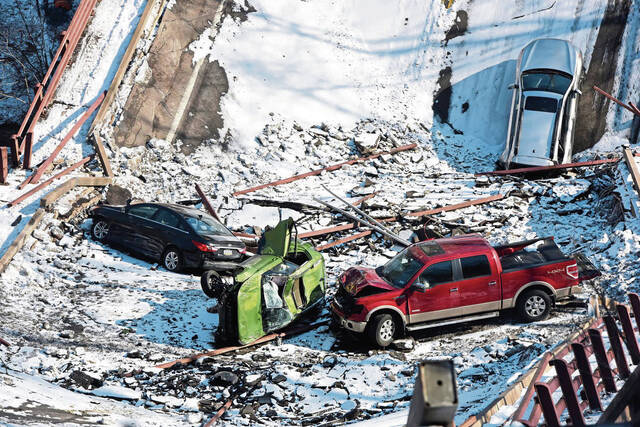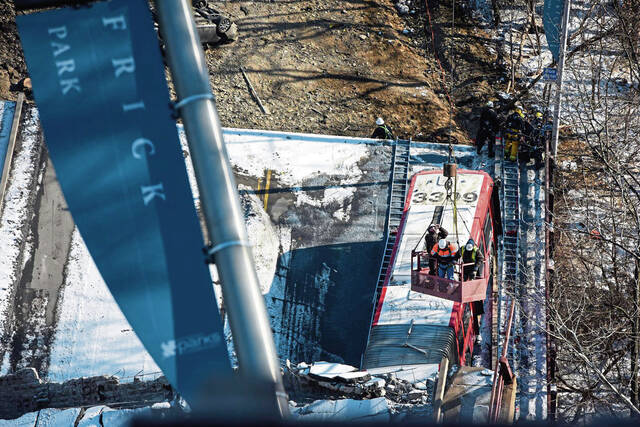A Pittsburgh Regional Transit operator hurt when the Fern Hollow Bridge collapsed under his bus more than two years ago filed a detailed lawsuit Thursday against the City of Pittsburgh and three engineering firms, accusing them of negligence in failing to correct longstanding problems with the heavily corroded span.
Daryl Luciani, along with his wife, Karen, sued Pittsburgh, as well as engineering firms CDM Smith Inc., Gannett Fleming Inc. and Larson Design Group.
Also suing was a dentist who was traveling from his Monroeville home to his Squirrel Hill practice when he was caught up in the disaster.
Clinton Runco broke his neck, sternum and several ribs after his car shot into the void caused by the collapse. His wife, Irene, who was not with him, is also listed as a plaintiff.
“The engineering companies’ incompetence, coupled with the city’s inaction, created a recipe for disaster,” Runco’s lawyer, Jason Matzus, told TribLive. “Collectively, over 15-plus years, the defendants literally watched the Fern Hollow Bridge rot, crumble and deteriorate until the inevitable occurred — it collapsed.”
Matzus claimed that the city and firms turned a “blind eye” to public safety.
“It is beyond any credible dispute that the collapse of the Fern Hollow Bridge was 100% predictable and 100% preventable,” Matzus said.
Messages left for the engineering firms Thursday were not immediately returned.
The lawsuits mark the latest step in the lengthy litigation process during which plaintiffs’ lawyers sparred with Pittsburgh for information and details about the engineering firms as they worked to determine who to sue.
The law caps the city’s damages at $500,000 for all plaintiffs, but no such limit exists for the engineering firms if they are found liable.
Other plaintiffs expected to file on Thursday include the bus’s two passengers, Matthew Evans and Anna Nichols, and motorist Joseph Engelmeier.
Velva and Tyrone Perry, who were hurt when their pickup fell into the gorge below the bridge, and Thomas Bench, and his wife, Sara, already filed their formal complaints.
According to Luciani’s complaint, CDM Smith was contracted with the city to perform inspections on the bridge from 2005 through 2019; Gannett Fleming inspected the bridge from 2020 through 2022; and Larson Design Group did inspections from 2020 through 2022. The complaint says that the city would have expected Larson to be able to properly select and hire firms to work on the bridge.
Upcoming Local Events
CDM Smith is headquartered in Massachusetts, Gannett Fleming operates out of Camp Hill, and Larson Design Group is based in Williamsport. All three have Pittsburgh regional offices.
The lawsuit alleges that neither the city nor Larson did any background checks on CDM Smith or Gannett Fleming to determine if they had been sued before or paid prior settlements or to determine their safety history, assess their reputations among other engineers or review other governmental contracts they’d completed.
CDM Smith has paid more than $40 million to settle lawsuits over alleged negligence and deficiencies at water and sewer treatment projects in Massachusetts, New Mexico and California in the past decade, the complaint said.
CDM Smith also disclosed bribes to Indian government officials to obtain highway and water projects, earning the company $4 million in profits later turned over to the federal government, according to the lawsuit.
The complaint also alleges that Gannett Fleming has previously been investigated for design, engineering and maintenance failures.
In the end, though, the complaint made clear that the City of Pittsburgh bears the final responsibility for the collapse.
“Even though it contracted those inspection services to the entities named herein, the city remained ultimately responsible for the safety and maintenance of the bridge and the accuracy of the bridge inspection reports,” Luciani’s complaint said.
The 447-foot Fern Hollow Bridge, built in 1970, connected Regent Square and Squirrel Hill.
Built of uncoated weathering steel, it carried roughly 14,000 vehicles a day over a ravine in Frick Park.
But at 6:40 a.m. on Jan. 28, 2022, it collapsed, sending five vehicles, including an articulated bus, 100 feet into the gorge below.
Nine people were inside the vehicles — all the plaintiffs, plus another person who has never been publicly identified. No one was killed.
It was snowing that morning, and area schools had been delayed, resulting in significantly less traffic than normal on the bridge at that time of day.
Luciani’s attorneys, Peter Giglione and Steven Barth, wrote in the complaint that when the bus landed from its 100-foot drop, Luciani could not see where he was or whether it was safe to move.
Featured Local Businesses
“In fact, because of the downward-facing angle of the rear of the bus, and Mr. Luciani’s inability to see it, he believed at the time that the rear of the bus was still hanging in the air well above the ground, and that if he or his passengers moved, the bus would fall backwards into the ravine, killing Mr. Luciani and his passengers,” the lawsuit said.
Luciani called his dispatcher for help and opened his window, hearing the loud “whooshing” noise of a broken natural gas line.
“At that point, Mr. Luciani thought that he and his two passengers would be killed by a natural gas explosion,” the complaint said.
He called his wife to tell her that he loved her because he believed he would never see her again.
Luciani and the passengers were rescued 15 to 20 minutes later by emergency responders.
He sustained a large rotator cuff tear in his left shoulder and continues to have post-traumatic stress disorder, including nightmares, fear of crossing bridges, anxiety and depression.
He can no longer work as a bus driver. These days, the 60-year-old from West Newton is a toll collector for Pittsburgh Regional Transit.
At a hearing in February, the National Transportation Safety Board said that the bridge collapsed because of a failure of a transverse tie plate, a critical part of one of the legs.
“This bridge did not collapse by an act of God,” said board member Michael Graham. “It collapsed because of a lack of maintenance and repair.”
The collapse, the members concluded, traced to the city’s failure to address inspectors’ “repeated” maintenance and repair recommendations. Further, the safety board investigators criticized the quality of the inspections, as well as the calculations to determine the bridge’s weight limit.
“It really was a cascade of failures from the local government to the state to the Federal Highway Administration,” said board Chair Jennifer Homendy.
At the time of collapse, the bridge’s load capacity was 26 tons, but the board concluded that the calculations to reach that rating were done incorrectly.
The calculation failed to account for an additional three inches of asphalt paving on the bridge deck. With the additional weight, the load rating would have been reduced by three tons and would have required closure, the NTSB found.
Upcoming Local Events
In other words, the Fern Hollow Bridge, the safety board said, should not have been open to traffic on the day it fell.
Beginning in 2014, the lawsuits said, the Fern Hollow Bridge underwent annual inspections because of its condition.
The complaints allege that the defendants knew as early as September 2005 that the bridge had partially or fully clogged drainage inlets, that water was leaking onto the southwest leg, that severe corrosion, causing section loss, was occurring on the cross bracing between legs and that there was heavy section loss on transverse stiffeners on all bridge legs.
The complaints go on to list the continued deterioration over the next 16 years.
Part of the problem stemmed from the clogged drains, which led water to run down the bridge’s legs and accumulate. The special alloy from which the bridge was built was meant to develop a corrosion-resistant coating, but that couldn’t happen if the bridge wasn’t able to dry.
The lawsuits accuse the engineering defendants of failing to identify the legs as “fracture critical” and of failing to recommend sufficient maintenance to prevent the bridge’s collapse.
A bridge component is fracture critical if its failure could cause a partial or full collapse.
The engineering firms are also accused of failing to properly calculate the bridge’s capacity.
The Fern Hollow Bridge was a K-frame structure, one of only six such bridges in Pennsylvania as of January 2022.
A K-frame bridge is known as a non-redundant bridge, the complaint said, meaning that the design has limited ways to disperse the stress on the bridge.
“Prior to the collapse of the bridge, defendants knew that if any of those paths on this bridge failed, so would the whole structure,” Luciani’s complaint said. “Defendants knew that non-redundant bridges have collapsed in the United States before the Fern Hollow Bridge collapsed.”
The lawsuit alleges that over the past 30 years, engineering codes began to penalize firms using non-redundant bridges because they are known to be less safe than redundant bridges.
Non-redundant bridges, the complaints allege, require traffic flow restrictions, more stringent inspection guidelines and more extensive inspections.
Featured Local Businesses
Paula Reed Ward is a TribLive reporter covering federal and Allegheny County courts. She joined the Trib in 2019 after spending nearly 17 years at the Pittsburgh Post-Gazette, where she was part of a Pulitzer Prize-winning team. She is the author of “Death by Cyanide.” She can be reached at pward@triblive.com.





